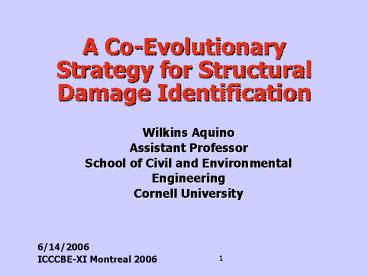A CoEvolutionary Strategy for Structural Damage Identification - PowerPoint PPT Presentation
1 / 22
Title:
A CoEvolutionary Strategy for Structural Damage Identification
Description:
School of Civil and Environmental Engineering. Cornell University. Structural Health Monitoring and Prognosis Group. 6/14/2006 ... – PowerPoint PPT presentation
Number of Views:37
Avg rating:3.0/5.0
Title: A CoEvolutionary Strategy for Structural Damage Identification
1
A Co-Evolutionary Strategy for Structural Damage
Identification
- Wilkins Aquino
- Assistant Professor
- School of Civil and Environmental Engineering
- Cornell University
2
Acknowledgments
- This work was carried out in collaboration with
- Hod Lipson and Josh Bongard
- Computational Synthesis Lab, Mechanical and
Aerospace Engineering - Cornell University
3
Outline
- Motivation
- Background
- Coevolution and Damage Detection
- Numerical Examples and Results
- Conclusions
4
Motivation
- One of the main challenges in structural damage
identification is how to obtain sufficient
information to accurately quantify the state of a
given structure. - In many problems, a single test does not suffice
to thoroughly characterize a system. - Multiple tests can increase the level of
information and observability of a system in many
practical problems. However, how can we decide
what tests to perform in order to maximize
information?
5
Co-evolution
- A strategy based on co-evolution will be
presented that not only searches for damage, but
also helps in the selection of structural test
that elucidate new information. - What is co-evolution? A biological process where
populations of interacting individuals challenge
each other in an ongoing cycle of adaptation
(e.g. preys-predators Preys evolve to elude
predators, while predators evolve to catch the
preys)
6
The Estimation-Exploration Algorithm (EEA)
- Uses the notion of co-evolution to find good
solutions with minimum physical testing. - Two phases Estimation and Exploration.
- Estimation phase A set of candidate solutions
are evolved based on current tests. - Exploration Phase Tests are evolved to maximize
discrepancy among current candidate models. - Some applications
- Damage identification in structures
- Gene network inference
- Automated robot function recovery
- Identification of dynamical systems
7
Estimation-Exploration Algorithm (EEA)
8
Co-Evolutionary Damage Detection The Concept
Estimation Phase Find candidate models that
predict current tests
Physical system
GA
F
U
Exploration Phase Find tests that create
discrepancy among solutions
GA
The answer
9
Example Structural Damage Detection in Truss
Structures
10
Problem Description
Equilibrium equations
Damage representation
11
The Estimation Phase
- The estimation phase consists in finding
candidate damage scenarios that minimize the
error between the predicted response and the
tests that have been carried on the structure. - Multiple damage scenarios will be found as long
as tests do not carry sufficient information to
determine a unique solution. - Candidate damage scenarios are transferred to the
exploration phase.
Optimization problem
12
Test Encoding in Exploration Phase
13
The Exploration Phase
- The goal of the exploration phase is to find a
test that maximizes discrepancy among candidate
solutions (i.e. damage scenarios) selected from
the estimation phase. - The fitness of a test in the exploration phase is
proportional to its ability to create
disagreement among candidate solutions.
Optimization problem
14
Stopping Criteria
- One individual can explain all tests in a
predefined number of consecutive cycles. This
indicates that a potentially good solution has
been found. - Diversity is not maintained. At least two
different individuals need to be transferred from
the estimation phase to the exploration phase.
Loss of diversity may be due to various factors
such as inadequate parameters in the niching
method, size of the population, number of
generations, etc. - The exploration phase cannot find a test that
causes disagreement among candidate solutions. In
this case, the algorithm cannot single out a
unique solution. This situation may indicate that
the problem is not fully observable
15
Numerical Examples
- Five damaged elements.
- Tests encoded three vertical loads and three
sensors. - Loads applied only on the bottom chord.
16
Results
- Two different strategies
- EEA
- Control algorithm tests were generated randomly.
That is, exploration phase was deactivated.
17
Results (2)
EEA. No Noise. 10 Tests.
Control. No Noise. 10 tests.
18
Results (3)
EEA. 1 Noise. 10 tests.
Control. 1 Noise. 10 Tests.
19
Results(4)
Subjective Error
Objective Error
20
Evolution of Tests in EEA
21
Conclusions and General Remarks
- EEA has shown promise for its application in
damage identification problems. - It has been shown that EEA is a better
alternative than blind testing of a structure and
even engineered tests. - Further studies will consider its extension to
crack identification in continua.
22
References
- B. Kouchmeshky, W. Aquino, J.C. Bongard, and H.
Lipson (2007).Coevolutionary Strategy for
Structural Damage Identification using Minimal
Physical Testing. International Journal for
Numerical Methods in Engineering Volume 69, Issue
5, pp 1085-1107. - B. Kouchmeshky, W. Aquino, and Adam E. Billek.
(2007). Structural Damage Identification Using
Frequency Response Functions and Coevolutionary
Algorithms. Journal of Structural Control and
Health Monitoring, Volume 15, Issue 2, pp 162-182.































